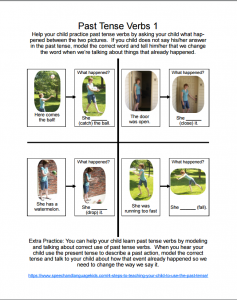Past Tense Picture Describing Activity

Description: Have you ever struggled to get a child to talk about things in the past tense? I love using two pictures for this. This is also great for children who are struggling with memory and recall as well! The first picture should represent an action that is about to happen or is currently happening. Then the second picture should represent right after that action happened. If you’re cool like me, you can have your roommate take a whole bunch of pictures of you completing actions outside of your apartment. Or you can just use our pre-made pictures here 🙂
Show the child the first picture and describe what is happening using the present tense. For example, in the first pair of pictures above, you would say “Here comes the ball!”. Then, you point out the second picture and say “What happened?”. The fact that the action is over in the picture prompts the child to use the past tense. If he does not use the proper past tense, you cue it with “This is something that already happened so we have to change the word we use. Instead of catch, we say ‘caught’.” You can also use this to talk about the difference between regular and irregular past tense verbs. You can explain how most of the time we just add “-ed” to the end of a word to show that it already happened. But some words and special and use different words.
Click Here to Join the Membership and Download this Activity Right Now!

